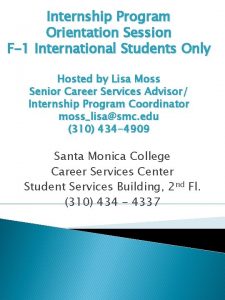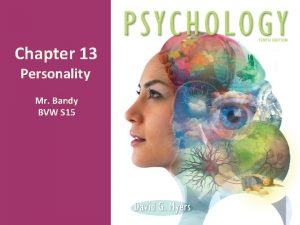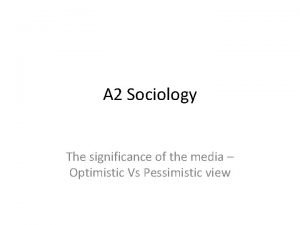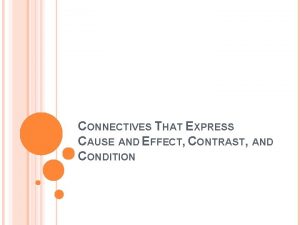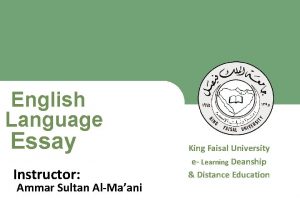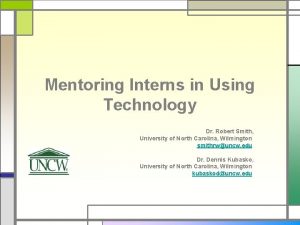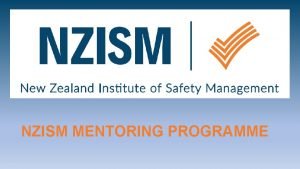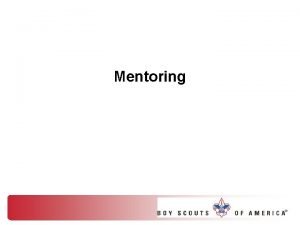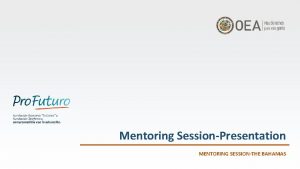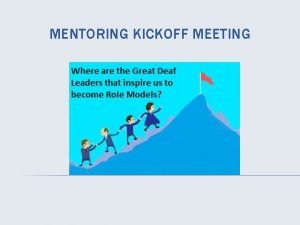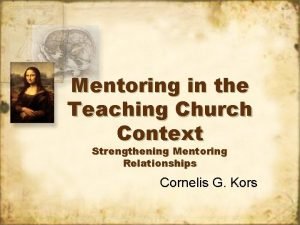Mentoring Interns in using Technology Cause for Optimism

























- Slides: 25

Mentoring Interns in using Technology: Cause for Optimism or Reasons for Concern Robert Smith smithrw@uncw. edu Dennis S. Kubasko, Jr. kubaskod@uncw. edu University of North Carolina Wilmington http: //people. uncw. edu/kubaskod/

Overview and Perspectives n n Understandings of learning to teach typically involve the placement of a mentee or novice teacher with a more experienced mentor whose role is to supervise and guide the mentee. However, with regard to emerging technologies, many mentees are more knowledgeable and skilled in the use of such technologies than their mentors (Dexter & Reidel, 2003).

Purpose n The study examines secondary interns’ use of technology in teaching and learning and the mentoring provided by their partnership teacher.

Research Questions n n n How and why are interns using technology in teaching and learning? What mentoring does the partnership teacher provide to the intern in their use of technology? How does the mentoring affect the interns’ use of technology?

Perspectives and Theoretical Framework n n n The National Educational Technology Standards for Teachers (NETS-T) proposed by the International Society for Technology in Education (ISTE) provides six standards for inclusion of technology in all teacher education programs. The overall goal, as described in Standard 3, is that teachers use methods and strategies for applying technology to maximize student learning. The NETS-T standards call for all interns to be “supervised by a mentor or master teacher on a consistent basis” to enable them to become proficient and technologically literate (ISTE, 2003).

Preservice Teacher Use of Technology n n Preservice teachers’ level of comfort and skill in using technology has been seen as leading to an increased use of computers in instruction (US Department of Education, 2000) and thus, as a possible catalyst for changing instruction (Pedretti, Smith-Mayer, & Woodrow, 1999). However, others have argued that future teachers need to have more experience with technology and receive more guidance in the use of technology (Lemke & Coughlin, 1999).

Mentoring and Technology Use n n n In a recent study of student teachers, 30% indicated that instructional support for technology at their student teaching site was “fair” to “poor, ” and when asked whether their cooperating teacher used and modeled technology integration in their teaching, most responded “strongly disagree” (Dexter & Reidel, 2003). Various explanations have been provided for why teachers do not use emerged or emerging technology. These include: lack of teaching experience with new technology; lack of on-site support; lack of help supervising children; lack of specialist technology teachers; lack of computer availability; lack of time and lack of financial support (Mumtaz, 2000).

Previous Work n n This is the third year in our study of our secondary interns’ use of technology during the internship. Interns on average rated their skills with using technology higher than that of their partnership teachers. Interns viewed the barriers to technology as being less substantial than their partnership teachers; however there were few differences between partnership teachers’ and interns’ in their beliefs about the value of technology integration. The findings of the study raise some important issues about interns’ use of technology in teaching and learning and the problems of providing appropriate mentors. (Smith and Kubasko, 2005)

Participants n n n The participants were enrolled in a 2004 -2005 secondary teacher education program at UNCWilmington. Eighty-one secondary interns participated in the study representing the following seven content areas: English (25), mathematics (9), social studies (22), physical education (11), science (8), foreign language (3), and music (3). Three social studies interns and their partnership teachers and three science interns and their partnership teachers were selected for more detailed study of the mentoring relationship.

Methods n “Intern Surveys” n n All secondary interns were surveyed at the end of the internship about their use of technology. “Case Studies of Mentoring Relationship” n Three science and three social studies interns and mentors were selected to illustrate a range of mentoring relationships in relation to the interns’ use of technology.

Methods n “Intern Interview” n Case study interns were interviewed twice about the mentoring received n n n “Technology Log” n n n beginning of the internship end of the internship Interns completed a technology log at two different points during student teaching. The interns use the log to describe their use of technology as well as record any conversations with their partnership teacher about their use of technology. “Intern Observation” n Each intern was also observed four times by one of the authors teaching a ninety minute lessons.

Methods n Other data sources n n assignments completed for student internship which required the use of technology (e. g. a two week unit plan submitted using Task. Stream, an electronic toolset). “Case Partnership Teachers” n Case study partnership teachers were interviewed twice about their use of technology and about the mentoring offered for their intern. n n beginning of the internship end of the internship

Findings n Intern Survey (n=81) n Interns described their skills with using technology in teaching and learning: n n 1% novice, 24% intermediate, 70% advanced, and 5% expert. Intern use of technology includes: n 100% used word processing and email, 96% used internet searches, 83% used presentation software, 50% developed a teacher web page, 48% reported using an LCD projector, and 15% reported using handheld computers

Findings - Intern Survey (n=81) n On a four point Likert scale, interns responded to each item (Strongly Disagree - 1; Disagree - 2; Agree - 3; Strongly Agree – 4) n n n “I support the use of technology in the classroom” = 3. 7 “Student motivation increases when technology is integrated into the curriculum” = 3. 2 “There is enough time to incorporate technology into the curriculum” = 2. 8 “Your partnership teacher played a significant role in their overall experience” = 3. 4 “Your partnership teacher used and modeled technology” = 2. 6 “My partnership teacher provided guidance on technology” = 2. 5.

Findings - Intern Survey (n=81) n Interns were asked to evaluate the role played by other individuals in their experience of learning to teach with technology. n n The following mean scores were generated: university supervisor (2. 6); methods instructor (3. 0); high school technology coordinator (2. 0) and high school students (2. 6). While 35% of interns indicated that their partnership teacher was the main source of support for technology integration, n 65% indicated other main sources (26% other interns, 25% university supervisor, 9% other teachers and 6% school technology coordinator).

Findings n Social Studies Intern Cases Two of the three social studies interns, Amber and Sandra, described receiving good mentoring from their partnership teacher. n Amber described her mentor: “She modeled and supported my use of technology. She is a digital goddess. ” n

Findings n Social Studies Intern Cases n n Sandra described the role played by her partnership teacher. “He had to teach me how to do everything. He [provided guidance] with Power. Point. He would say this is good and make sure you put this on your Power. Point so students understand this. This is a good website. ” However, George, the third social studies intern, received only minimal mentoring, with no modeling or guidance.

Findings n Science Intern Cases Two out of three science interns, Anna and Renee, expressed confidence in the mentoring they received from their partnership teachers. n Anna described her partnership teacher, “she is so ready to use technology in everything that we do and I just didn’t fathom that I could do that much with it. ” n Renee agreed, “We don’t really differ. I use a lot of stuff he uses because it works…” n

Findings n Science Intern Cases n Janice felt differently. She stated “So I think maybe she’s a little intimidated or something like if we have to change something on the power point or something like that, I’m the one that does it and that’s fine. But it’s just that maybe she’s a little hesitant and I’m not. ” She expressed reservations about her partnership teacher’s ability to adjust to the changing technology.

Discussion n n As this study indicates, there are examples of mentor teachers modeling and guiding interns in the effective use of technology in teaching and learning. However, these teachers tend to be the exception. Intern mentoring in the use of technology often consists of limited modeling, with general praise for the interns use of technology but little specific guidance. Finally, where technology is being used, it is mainly by the teacher. There are only limited examples of teacher directed student use of technology.

Discussion n What is most striking is the variation between classrooms in the use of technology and in the quality of mentoring available to interns. This in part would seem to reflect that technology use is a complex outcome influenced by a number of factors. These include: 1) the larger societal context of national and state standards; 2) the local or school context, including access and support for the use of technology, and 3) the individual teacher’s knowledge, skills and interest in technology.

Conclusion n In examining the use of technology in schools, Means (2003) notes, “teachers have considerable latitude. . . in interpreting and implementing policies developed at higher levels of the education system” (p. 159). Teachers are viewed as mediating instruction and thus mediating the use of technology. This perspective on the role of teachers as mediating policy is consistent with Burney’s (2004) characterization of the teaching profession as based more on craft knowledge than “research knowledge. ”

Conclusion n Burney argues that, even though there is a body of research knowledge, it is shared only haphazardly among teachers. Furthermore, craft knowledge is “largely hidden because there are no institutional arrangements for codifying, legitimating and sharing it” (p. 527). Consequently, “each teacher is left to invent his or her own knowledge base – unexamined, untested, idiosyncratic, and potentially at odds with the knowledge from which other teachers may be operating” (p. 528).

Conclusion n Burney’s characterization of teaching as lacking a shared knowledge base and in need of an entirely new professional culture in schools and districts, would seem to offer insights both in relation to the use of technology as well as the mentoring available to interns.

Mentoring Interns in Using Technology: Cause for Optimism or Reasons for Concern Robert Smith smithrw@uncw. edu Dennis S. Kubasko, Jr. kubaskod@uncw. edu University of North Carolina at Wilmington http: //people. uncw. edu/kubaskod/
 Objectives of internship orientation
Objectives of internship orientation Organs interns del cos huma
Organs interns del cos huma Uninformed optimism curve
Uninformed optimism curve Martin seligman learned optimism test
Martin seligman learned optimism test Optimism in face of uncertainty
Optimism in face of uncertainty Optimism vs pessimism
Optimism vs pessimism Optimism vs pessimism
Optimism vs pessimism Autentichappines
Autentichappines Optimism
Optimism Uninformed optimism
Uninformed optimism Therapeutic optimism
Therapeutic optimism Ter thin client
Ter thin client Ultimate cause of behavior
Ultimate cause of behavior Proximate causation biology example
Proximate causation biology example Imprinting example
Imprinting example Adverb of cause and effect
Adverb of cause and effect What's a subtopic
What's a subtopic Fspos vägledning för kontinuitetshantering
Fspos vägledning för kontinuitetshantering Novell typiska drag
Novell typiska drag Tack för att ni lyssnade bild
Tack för att ni lyssnade bild Returpilarna
Returpilarna Shingelfrisyren
Shingelfrisyren En lathund för arbete med kontinuitetshantering
En lathund för arbete med kontinuitetshantering Personalliggare bygg undantag
Personalliggare bygg undantag Tidbok för yrkesförare
Tidbok för yrkesförare Anatomi organ reproduksi
Anatomi organ reproduksi
